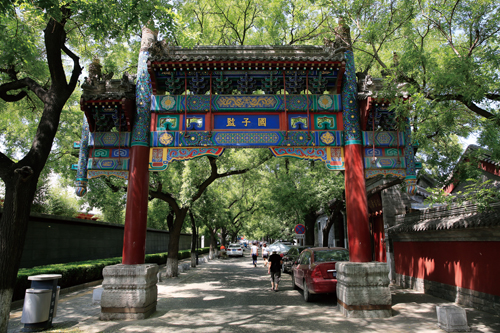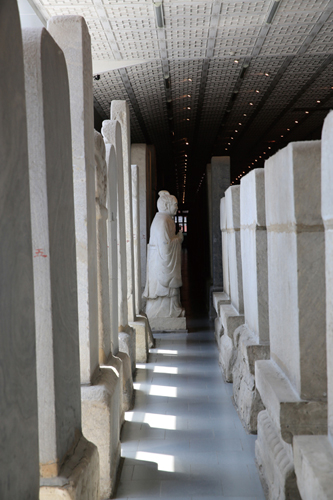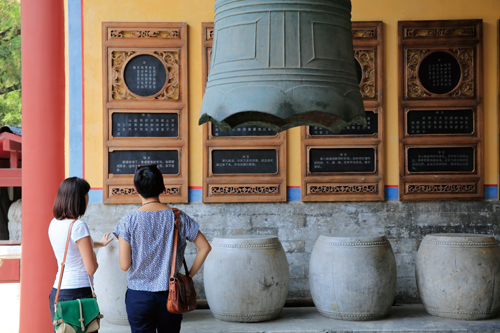It’s 10am on a clear July day and I’m about to start a history walk with Nelly Alix of Beijing by Heart. We’re exploring the old Tartar City around the Confucius Temple and the Imperial Academy. The three-hour tour starts near the Lama Temple, stops at Guozijian, continues south to Beixinqiao through the hutongs, and ends at the Duan Qirui Former Government Building, a mysterious compound near Zhangzizhonglu.
About a year ago, Alix and her co-founder Lucile Dinh were hired to write the Louis Vuitton City guide for Beijing. For three months, the self-confessed “Chinese history nerds” rekindled their fascination for the past by scouring the city for hidden gems. They started Beijing by Heart after a period of guiding “friends and friends of friends,” a project made possible by their freelance schedules.

After meeting at exit D of Yonghegong subway station, we head south on Yonghegong Dajie (雍和宫大街) and turn right on Guozijian Jie (国 子监街). The street was built over 700 years ago during the Yuan Dynasty, but its layout remains largely intact. You’ll recognize it by the arched gate (pailou) inscribed with the street’s former name: Chengxian Jie (成贤街) or “perfect virtue.” Traditionally, pailou were built near temples to commemorate the virtuous.
Starting from 1645, only the Manchu were allowed to live north of Qianmen; all Chinese were relegated to the outer city in the south. “All theaters and places of entertainment had to be in the outer city to prevent the bannermen from becoming too soft,” says Alix. “That’s why you won’t see any around here.” The inner city also contained storehouses for products like grain and wax, hence present-day hutong names such as Nanmencang (“southern gate storehouse”) and Baimicang (“rice storehouse”).

Upon entering Confucius Temple, we head to the rows of imposing stone steles (upright stone slabs or pillars) to the right dating from the 14th to 20th centuries. They contain the names and origins of successful imperial examination laureates, with the seal of the emperor engraved at the top of each pillar. “The purpose was to honor and humble at the same time, reminding them that they were only one among thousands of civil servants,” says Alix.
In the inner courtyard, primary school students are having a graduation ceremony complete with Chinese pop. I strain to hear Alix over the music as she points to a large cypress tree to the left of the stairs. “That tree has its own legend,” she says. “During the Ming Dynasty when the imperial procession came, a branch knocked off the hat of a corrupt minister. Since then, it has been called the ‘touch evil tree.’”
We ascend to the Hall of Great Perfection (大成殿, dacheng dian), where each emperor paid his respects to Confucius. The inscription over the door – “a teacher for each generation” – was made by Emperor Qianlong, a keen calligrapher and poet. The hall contains reproductions of common sacrificial items, including animals and urns full of rice and wine.

Next to the Hall of Great Perfection, there’s a dimly-lit, air-conditioned exhibition hall filled with massive steles – “an absolute treasure of history,” says Alix. To protect the 13 classics from destruction, the Qianlong emperor commissioned the best calligrapher in his court to engrave them in stone – a project that took nine years. The writing on some steels is almost completely faded while others are perfectly clear thanks to extensive restoration.
We continue next door to the Imperial Academy, where the brightest students from around China came to prepare for the imperial examinations. “In theory, all men of the realm – even the son of a peasant – could take the examination and become a minister,” explains Alix. But in practice, only the nobility could afford the luxury of time and private tutors.

The countless red tags hanging on the statue of Confucius in front of the Emperor’s Lecture Hall (辟雍, biyong) are wishes for success left by the families of high school students taking the gaokao. The hall itself is where each emperor would lecture about the classics once during his reign.
It’s difficult to convey the backbreaking nature of the imperial examinations. For starters, all candidates had to learn the 13 classics by heart, which required 10-15 years of study. The examinations and degrees were divided into ranks; only 300 people passed the municipal examinations every three years.
The most important part of the exam was the “eight-legged essay” in which eight paragraphs of prose followed a very rigid – some would say pedantic – structure and were required to quote the classics. “If one stroke was wrong, that was enough to make the person fail,” says Alix.
The small exhibition room next to the Emperor’s Lecture Hall is worth visiting for the reproductions of the examination cubbies alone. However, the highlight was a length of silk painstakingly covered in tiny Chinese characters – an ancient cheat sheet worn as an undergarment. The temptation to cheat was overwhelming, so each candidate was thoroughly searched before the exam. “If you brought jiaozi, they would be taken apart,” says Alix. Each essay was even re-transcribed by a copyist to ensure examiners couldn’t recognize a student’s handwriting.
The pressure was overwhelming. Many went mad during their exams or committed suicide. “It was said that the spirit of failed candidates were reincarnated as flies,” says Alix. “The fly could come sit on the ink of a newly-drawn character and mess it up, thus making the candidate fail. Or if they were worthy, the fly might add a forgotten stroke.” But if the candidate was successful, their families would be “covered in honor” for generations.
After exiting the Imperial Academy, we head west on Guozijian and turn left down Gongyi Xiang (公 益巷). Alix explains that the name Tartar City is based on a geographical blunder. “Tartar,” which comes from the word “Tartarus” (Latin for “hell”), was the name given to invading Mongols by the Russians. However, the Manchu are from Dongbei, not Mongolia.

Our guide points out decorative features on siheyuan entrances. For instance, the wooden knobs above doorways are traditionally inscribed with the lucky characters jixiang ruyi (吉祥如意). Smaller doors with only two ornaments are called ruyi men (如意门); doors large enough to accommodate the whole phrase signified a higher social status.
On reaching Fangjia Hutong (方家胡同), Alix gestures to the Fangjia 46 compound. During the Sino-Japanese War, Mao Zedong moved many factories into city out of concern they’d become easy targets if located too far out. Fangjia 46 used to house a collection of small factories, which have since been converted into galleries, cafes, and restaurants. If you need a break, try Aimo Town for Yunnan food,Trainspotting for Guizhou cuisine, or Twin Cities for coffee.
We then walk east on Fangjia, turn right on Yonghegong Dajie, and cross Dongzhimen Neidajie to reach Beixinqiao subway station, exit C. Alix takes us between the grayish blue apartment buildings just south of the subway; the path opens onto Xiang’er Hutong (香饵胡同). In about 200m, we turn left on Huageng Hutong (花梗胡同) and head south.
As we weave between retirees and flat-bed bicycles, Alix explains that many residents were first installed here by their danwei (单 位) or work unit. With government subsidies, one might pay less than RMB 100 per month for an 11-12sqm room. One of the biggest concerns for conservationists is that these locals will one day be priced out of the area, in the process eradicating small jobs such as bicycle repairmen and knife sharpeners.
We follow Huageng down to Bei Jianzi Xiang (北剪子巷) and Zhong Jianzi Xiang (中 剪子巷), where there’s a lively wet market with vendors selling grains, fruits, vegetables, flatbreads, and roast chickens. Once in a while, we see a little blue plaque above a siheyuan door. “That means the residents have applied for preservation,” says Alix. “If you get approval, your house can’t be destroyed and the neighbors can’t build extensions over it. But unless you have a real gem, the process can take several years.”

Eventually, we reach Zhangzizhong Lu (张自忠路) and head left until we reach a huge traditional doorway with guards. This is the Duan Qirui Former Government Building. You may be stopped by the guard, but just say you’re going to the cafe. You may also be asked to put away your camera, but you can pull it out again when you’re out of sight.
The first thing you’ll notice is the imposing, haunted-looking building just past the entrance. Built in the early 20th century, it served as the headquarters of Duan Qirui, a notorious warlord and the first premier of the Republic of China. It fell to the Japanese during the war and now serves as a downtown annex to Renmin University. Though you can wander freely through the ground-floor halls, most of the doors are locked.
Take your time strolling through the grounds; you’ll see early Republican buildings in disrepair with dramatic archways and large windows, as well as the occasional cat lazing on the lawn around the central square. Though there isn’t actually much to see, it’s easy to while away an afternoon in this lush, shaded compound.
Before leaving, head to Peanut in the southeastern corner of the grounds. This modest but comfortable cafe offers a welcome respite from the heat, serving iced coffee throughout the day and waffles in the afternoon. The gray-haired, bespectacled owner happens to be a Haidian history buff, so be sure to speak to him if you’re interested in Chinese history. An iced latte costs RMB 36.
Beijing by Heart tours offers tours in English and French. The history walks feature small groups of no more than eight people (minimum two), while the private tours can be one-on-one. Current walks include the Tartar City tour, the writers’ tour, the Forbidden City according to the life of Puyi, and the Yuanmingyuan Opium War tour.
Resources
Confucius Temple and Imperial Academy 孔庙和国子监
RMB 10, RMB 5 (students). Daily 8am-5pm (last ticket 4.30pm). 13 Guozijian Jie (near the Lama Temple’s main gate), Dongcheng District (8401 1977) 东城区国子监街13号
Trainspotting 猜火车
Daily 11am-11pm. 46 Fangjia Hutong, Dongcheng District (6406 0658) 东城区方家胡同46号艺术园区 (国子监南临)
Two Cities Cafe and Lounge
Mon-Fri 1-11pm, Sat-Sun 11am-11pm. 46 Fangjia Hutong, Dongcheng District (135 5238 7478) 东城区方家胡同46号
Aimo Town 埃蒙小镇
Daily 11am-10pm. Bldg G, 46 Fangjia Hutong (just south of Guozijian Jie), Dongcheng District (6400 1725) 东城区方家胡同46号艺术园区 (国子监南临) G座
Duan Qirui Former Government Building 段祺瑞执政府旧址
3 Zhangzizhonglu, Dongcheng District (6406 9687) 东城区张自忠路3号
This article originally appeared in beijingkids.
Photos: James Lindesay


